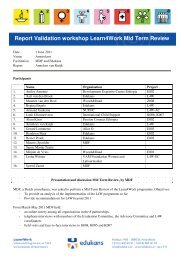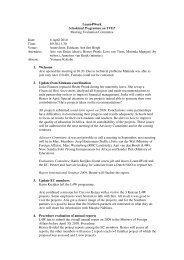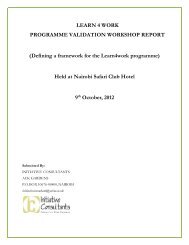Non â Formal TVET Mapping Survey Supported by Edukans ...
Non â Formal TVET Mapping Survey Supported by Edukans ...
Non â Formal TVET Mapping Survey Supported by Edukans ...
Create successful ePaper yourself
Turn your PDF publications into a flip-book with our unique Google optimized e-Paper software.
<strong>Non</strong> – <strong>Formal</strong> <strong>TVET</strong> <strong>Mapping</strong> <strong>Survey</strong> The case of Amhara, Oromia and Addis Ababa<br />
Minimum number of trainees could be 1.<br />
Training could be discontinued once need is met.<br />
4. Center based model: This entails giving training at well established training<br />
centers. Training given combines business and training. The training offered is<br />
decided in the beginning of the course in each training department. Trainees under<br />
the guides of the trainer are involved in the process of the whole order that<br />
includes:<br />
Estimating the cost of the product/service.<br />
Preparing a quotation and negotiating the price with the client.<br />
Preparing a job card and determining the order execution process.<br />
Cost effective purchase of raw material.<br />
Manufacturing and finishing the ordered item for providing the order<br />
service.<br />
Preparing a post-order cost calculation and determining the profit or loss.<br />
Delivering ordered items to the customer satisfaction.<br />
Sharing the profit between the trainee, trainer and training center based on<br />
pre-agreed norms.<br />
The curriculum based on developing competency to produce what is demanded in<br />
the market is developed.<br />
5. Linkage: The training provider enrolls trainees on the request of the employing<br />
company and gives training for a particular wage employment opportunity. For<br />
example: plumbers, tile layers, mesons etc are trained for large construction<br />
companies. This could be cause for people migration from rural areas to urban<br />
areas. Besides, the wage employment may not last long.<br />
3.4. Skills and Literacy Training for better Livelihoods<br />
The study made on 17 countries <strong>by</strong> IIZ/DVV revealed that:<br />
In all the countries studied, the diversity of possibilities for improving established<br />
livelihoods and developing new ones appears so wide as to the demand extreme<br />
flexibility, imagination and resourcefulness.<br />
All the programs examined dealt with very poor people mostly rural and mostly<br />
women.<br />
Among the ten recommendations made the following are noted relevant to our situation.<br />
At policy level assessment, of what is needed at locality level be made to enable<br />
giving training for livelihood earning.<br />
Decentralization and capacity nurturing for resourceful responses of potential<br />
partners be pursued.<br />
Policy should allow providing courses that combine savings and credit training<br />
with negotiated livelihood content and literacy/numeracy.<br />
Ensure that average adult learner master literacy and numeracy skills for use for<br />
livelihood development and the course be given in a term to maximize retention.<br />
Education Expertise Center Feb 2008 19







